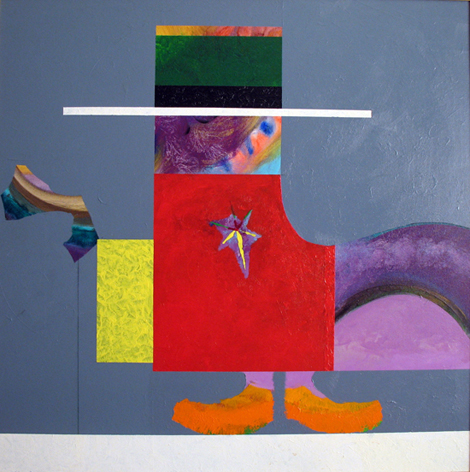Someone keeps making an appearance in Eugene J. Martin’s work, and I have no idea who, but I still recognize an old friend. He might be just passing through, with not much in the way of legs on those big orange feet supporting a boxy red body. He might be the silhouette of a black man, bent in sadness or just catching up on the daily news. He might be the debonair figure nestling a face rendered in shorthand into a cocktail glass, or the profile nursing a cigarette. To judge by titles like Detective Jones, Clever Sheriff, or Food and Drugs, he could be on either side of the law. Truth be known, he does not look much like the artist, but then Martin had more than his share of personalities within a single work, and they got along just fine.
He might be the artist himself, checking in to see how the work is going—it is going well. If this is portraiture, its real subject is painting. And painting here begins and ends with abstraction. It includes the enigmatic touches of color in place of a face, the spare horizontals of a top hat, or the circles bubbling up within a head. At least as often, it is a brighter geometry that lays the ground and then, increasingly, takes over the joint.
Martin, who died in 2005, is only now receiving his first long-overdue show in New York. That makes it easy enough to assign him any number of labels, all of them wrong. There are questions of racial identity in his enigmatic figures, while his color contrasts resemble those of Romare Bearden. He almost fits the profile of an outsider artist. Yet he studied at the Corcoran, and his drawings, in overlapping curves of graphite or pen-and-ink, make plain his knowledge of Cubism.
Martin, born in 1938, sometimes described his art as “satirical abstraction,” knowing full well that it is not at anyone’s expense and not entirely abstract. Yet the label does get at the seriousness, the comedy and the eclecticism. Like many younger artists, he might have leaped straight from an earlier Modernism to the graphic novel, with barely a nod to Abstract Expressionism in between. (Well, some of those floating fields of color do have a parallel in Hans Hoffman.) One can see him as putting abstraction through its paces.
A line of one color might leap across a single rectangle, over a brushier field, to land on the other side. Another line might have its own horizontal grid, like color swatches as a check on everything below—and at least one such color palette erupts out of a dark circle surrounded by feathery white, like a final vision. Maybe the star has finally taken over the show.


